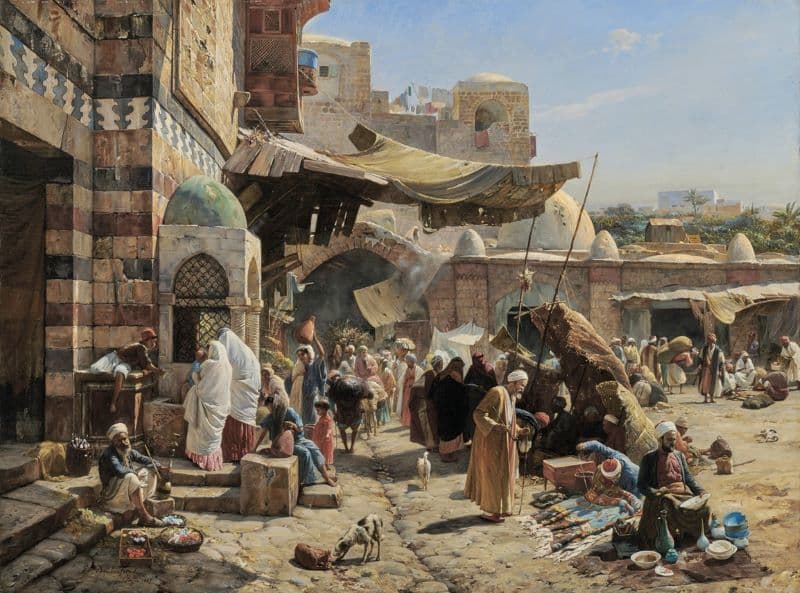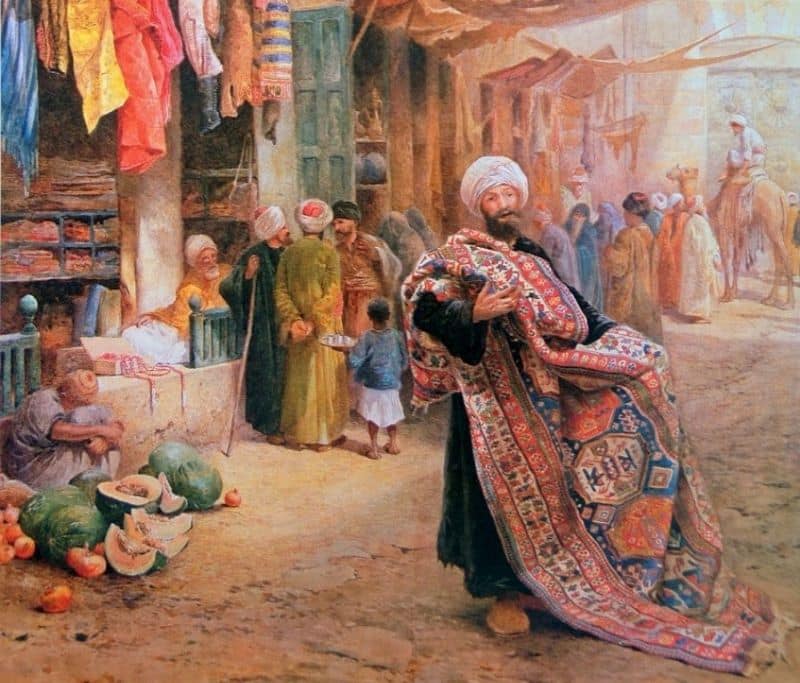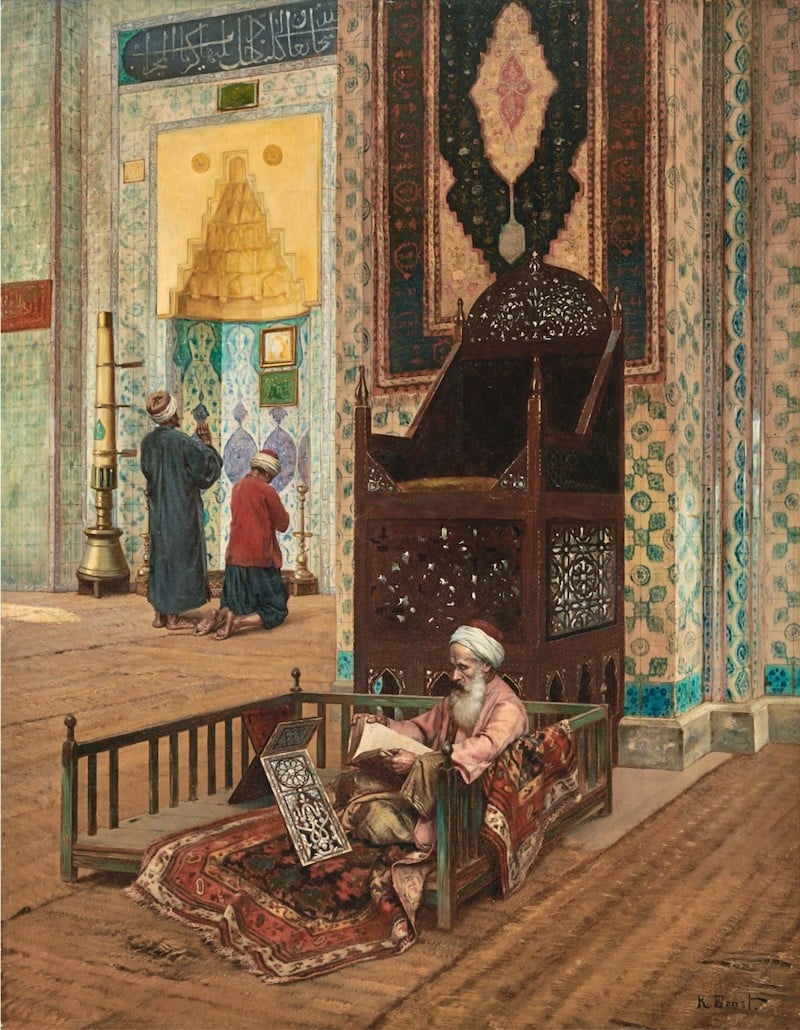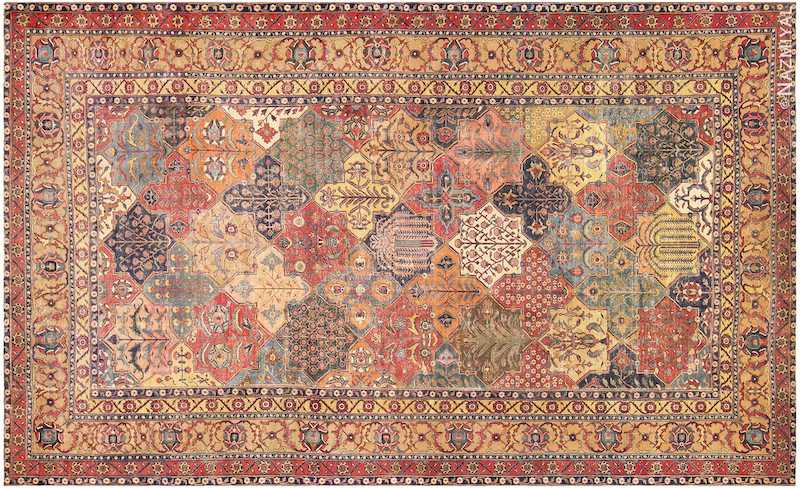Antique Orientalist Rug Bazaar Paintings: A Secret World Revealed
Oriental rugs are connoisseur’s art, much like fine wine and other antiquities. They have always been a symbol of the fine arts and were the realm of noblemen and kings throughout the centuries. It might seem like we have an abundance of these beauties at our disposal for our enjoyment, but the few that we have are only a fraction of the ones that are referenced in the historical records.
The thought of what these gorgeous creations might have looked like transports you into a world of imagination. The rugs themselves have faded from history and returned to the dust of the earth, but fortunately for us, some famous painters saw them as befitting subjects of interest. It is from this area of fine art that we have the best clues as to what these masterpieces looked like. Let’s delve into the world of the rug bazaar paintings and see what treasures await.
Persian and Oriental Rugs in Paintings
It is well known that Renaissance artists are a valuable source of information for early Persian and Ottoman rug designs, but some of the best information that we have comes from later artists. The late Middle Ages and Renaissance are considered the Golden Age of carpet and rug manufacture and design. It was during this time that many of the traditional designs and motifs came into existence. However, during the 18th century, many of the carpet weaving centers were affected by times of war and conquest. It was a time of relatively little new innovation or production.
In the late 19th century, there was a resurgence in interest in Oriental rugs, and many of the traditional weaving centers once again began production and the creation of new designs. This renewed interest in Persian carpets also caught the eye of Orientalist painters. They often traveled in the Near East, capturing what they saw with incredible detail. They developed strict practices and standards for the accuracy of their subjects. For us, this creates one of the best records of the carpets that existed during this time. One of the more abundant groups that depict rugs in paintings are the Rug Bazaar paintings. Let’s take a trip into the world of fine rugs during the second Golden Age of carpet weaving and the arts.

Market in Jaffa, an Orientalist painting by Gustav Bauernfeind.
Rug Bazaar Paintings and Artists
The complete list of Oriental rug bazaar paintings by Orientalist painters would be a voluminous effort, but we will try to give you a small sampling. Our first stop on this journey is a famous work by Jean-Leon Gerome.
19th Century Rug Bazaar Painting by Jean-Leon Gerome
One of the most famous Orientalist carpet bazaar paintings was created by Jean-Leon Gerome in 1887 and is called “The Carpet Merchant.” In this painting, we see a collection of smaller pieces crumpled on the floor, but the focal point of the painting is the magnificent medallion carpet hanging from the balcony. You can see the incredible detail of the carpet from the painting. You can also see a smaller carpet hanging behind it. On the floor, a group of wealthy buyers contemplates the purchase. An entourage of personal guards stands in the background. Perhaps the most remarkable aspect of this painting is that it gives us a clear view of the size and detail of this incredible work.

The Carpet Merchant by Jean-Leon Gerome
Orientalist and Rug Bazaar Painter Charles Robertson
Charles Robertson is another Orientalist painter who had a fascination with rugs and rug merchants. Many of his paintings recreated the markets of Cairo. One of the best examples is his painting, “A Carpet Seller, Cairo,” painted in 1887. This magnificent piece shows us snippets of several fine examples and draws our attention to one incredible masterpiece with an all-over design.
The artist captured the drape of the fabric in a way that translates into the depiction of a very fine weave. Once again, the artist gives us an idea of the scale of the piece in proportion to the human characters. Of note are the remarkable greens and brilliant purples of the carpets on the right hand side of the painting. These are rare colors, even today, and require incredible skills with natural vegetable dyes.

A Carpet Seller, Cairo by Charles Robertson.
Another painting of Charles Robertson of note is simply titled, “Cairo.” This one is significant because it shows presumably a merchant with a more typical example of what appears to be a village carpet. The carpet has a tribal design that is more typical of a village carpet of this time period. Also, you might note that the size of the carpet is smaller than those in other paintings.

Cairo by Charles Robertson
We saved the best for last. Charles Robertson’s, “The Carpet Bazaar, Cairo,” 1887, reads like an inventory of late 19th century carpets. In this picture, you can see examples from many parts of the world, including a distinctive Kazak carpet hanging on the left hand side of the painting. You can see a large, Ottoman carpet on the right side hanging in the farthest archway. You can also see what looks to be several examples of tribal and village carpets throughout the work. This painting shows the international reach and importance of the art of carpet making at the end of the 19th century. You are encouraged to zoom in on this one to truly appreciate the level of detail that the artist captured.

The Carpet Bazaar, Cario by Charles Robertson.
You can almost smell the coffee and spices as you wander through the Oriental rug bazaars created by these painters. There are many more artists and paintings that could have been included in this list. Rug bazaar paintings provided a glimpse into a world that was seen by few. For those who bought these rugs for their homes, it gave them an ancient mystique. For us, it gives us an appreciation for the fine examples that we still have in our possession. It places them in context as a world treasure and gives us a responsibility to preserve them.
Other Orientalist Art Collections and Rug Bazaar Pieces of Note
The works of Jean-Leon Gerome and Charles Robertson contain some of the most famous works that give us a glimpse into the world of Oriental carpets, but this style of painting inspired many others to follow in their footsteps. Sotheby’s Auction House has one of the most extensive Orientalist painting collections in the world. Let’s see if we can spot a few more of these beautiful rugs in them.
The Najd Collection inspired Westerners to look beyond the confines of their own experience to explore the world beyond their borders. Ludwig Deutsch is another well-traveled painter. He is known for his accurate representations of textiles, carpets, and details in buildings. He often worked with early photos for accuracy, rather than relying on his own memory.
This painting is titled, “The Morning Prayer,” and was painted in Paris in 1906. The setting is a mosque and shows a man reciting morning prayers on a gorgeous Anatolian carpet. Of particular note is that the carpet is not a traditional prayer carpet or “mihrab’ design. It a longer rug of bright colors, but not particularly one designated as a “prayer” rug. This tells us that any carpet could e used as a prayer rug and that the practice was not necessarily limited to those of a specific design for that purpose.

“The Morning Prayer” by Ludwig Deutsch.
Another Ludwig Deutsch painting, “At Prayer, 1923,” shows a gorgeous ornate mosque carpet with a formal medallion design. You might notice that the colors and patterns of the carpet closely match the mosaic on the mosque wall.

“At Prayer” by Ludwig Deutsch
Frederick Arthur Bridgman’s trip to Egypt inspired only one painting, but it is an important contribution to carpet history. The painting is titled, “The Messenger,” and was painted in 1879. You can see glimpses of a larger carpet with a solid center. However, of particular note is the small one upon which the messenger is standing. This carpet is a common design of the time, and similar to many existing rugs.

“The Messenger” by Frederick Bridgman.
Frederick Bridgman also shows the utilitarian nature of the carpets and their importance in daily use. In “Learning the Quran,” these carpets seem to be rather coarsely woven and without a formal design, suggesting that their primary purpose is an ordinary functional floor covering.

“Learning the Quran” by Frederick Bridgman.
Rudolph Ernst’s, “The Mosque of Rustem Pasha, Constantinople,” shows several rugs used in daily life. The scholar sits on a brightly colored, smaller rug. A larger Persian example hangs on the wall. Throughout the floor, you can see layers of rugs in larger and smaller sizes with a brown weave, simple stripes and tone-on-tone patterns. One can only guess that these pieces are utilitarian pieces for the sole purposes of floor coverings. These area rugs are layered throughout the painting. This painting suggests that there were different classes of rugs with different intended purposes.

Rudolf Ernst’s “The Mosque of Rustem Pasha, Constantinople”.
“Playing the Derbakeh, Biskra,” painted in 1889 by Charles James Theriot, appears to show a carpet with a longer pile and simple geometric designs. This is possibly another one created for simple, utilitarian purposes and everyday use. The pile rug looks soft and warm from what you can see in the painting.

Charles James Theriat Playing the Derbakeh, Biskra
An Odalisque lounges on a balcony overlooking the water in, “Young Ladies on a Terrace in Tangiers,” by Rudolf Ernst shows several layers of carpets and several different levels of artistry. There seems to be a course brown carpet similar to those depicted in previous paintings. This seems to serve as a base or underlayment for the more beautifully decorated carpets.

“Young Ladies on a Terrace in Tangiers” by Rudolf Ernst.
This collection highlights the importance of carpets in the late 19th and early 20th centuries. You can certainly find many more examples that could be included. This collection suggests that you can find examples of simple, rugs that are made to serve a purpose, and you can find masterpieces meant to evoke the divine. When you consider the range and types of rugs found in these paintings, it becomes apparent that we only have a small fraction of those that were created still surviving today. This makes the task of preservation of utmost importance.
We, at Nazmiyal Rugs, are proud of our collection of these remaining remnants of a world that has all but turned to dust. Feel free to look around our treasured collection, and if you see one that you must have for your own, feel free to contact us and we would be happy to assist.
Here are some beautiful early rugs that are in line with the pieces seen in the iconic Orientalist rug bazaar paintings:
This rug blog about Orientalist bazaar paintings that depict carpets was published by Nazmiyal Antique Rugs.















